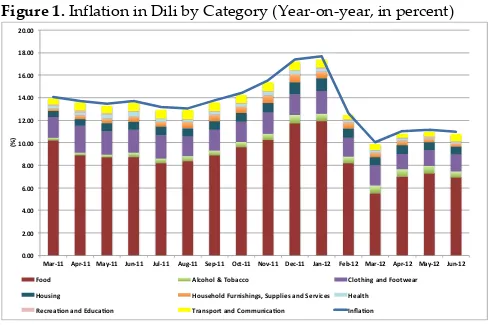National Directorate of Macroeconomics, DGPAR, Tel. +670‑333‑13‑37 Page 1
Summary
At the end of the second quarter of 2012 (Q2 2012) year‑on‑year inflation in Dili was 11% and in Timor‑Leste 10.9%. The divergence between CPI for domestically produced goods and CPI for imported products has continued during Q2 2012. The former increased to 14.8% (year‑on‑year) whilst the latter remained at 9.3%, a differential that may have resulted more from demand‑side factors than supply‑side ones. The recent appreciation of the USD and the decrease in commodity prices in Q2 2012 are both likely to contribute to lower inflation in the short term. In subsequent months, the prospective increase in international food prices may have inflationary effects, however these should somewhat be limited by strong expected domestic production.
Inflation Trend
Inflation in Dili increased moderately compared to
last quarter. After decreasing in February and March, food inflation in Dili has risen again (Figure 1) due to increases in the prices of cereals, roots and related products, fresh fish, nuts, fruits and non‑ alcoholic beverages. Overall, prices in June 2012 were 11% higher compared to June 2011.
Figure 1. Inflation in Dili by Category (Year‑on‑year, in percent)
Source: DNE & DNME
Inflation in Timor‑Leste (year‑on‑year) remained
very close to the rate recorded in the previous quarter at 10.9% (up from 10.8%). This continues the slowdown in rapid inflation rates to their lowest level since 2010, although it is still high by international standards.
Concerning the quarterly changes, prices were 0.8% higher in the end of June compared to the end of
March 2012. The food category continued to increase, albeit at a slower rate. No change was registered for the overall non‑food category. However, within this category, items such as transport and household supplies and services increased significantly, whereas items such as house building costs, household fuel and utilities and clothing and footwear decreased compared to Q1. Figure 2 illustrates that domestic and imported price increases continued to diverge in the second quarter. Imported inflation remained steady at 9.3% between Q1 and Q2 2012, while inflation for domestically produced goods increased from 14.3% to 14.8% during the same period.
Figure 2. Timor‑Leste Imported and Local Product Prices (Year‑on‑ Year, in percent)
Source: DNE & DNME
!"!!# $"!!# %"!!# &"!!# '"!!# (!"!!# ($"!!# (%"!!# (&"!!# ('"!!# $!"!!#
)*+,((#-.+,((# )*/,((# 012,((# 013,((# -14,((#56.,((# 789,((#:;<,((# =68,((#0*2,($#>6?,($# )*+,($#-.+,($# )*/,($# 012,($#
@AB
#
>;;C# -38;D;3#E#F;?*88;# G3;9DH24#*2C#>;;9I6*+# J;1KH24# J;1K6D;3C#>1+2HKDH24KL#51..3H6K#*2C#56+<H86K# J6*39D# M68+6*N;2#*2C#OC18*N;2# F+*2K.;+9#*2C#G;PP12H8*N;2# Q2R*N;2#
!"!#$ %"!#$ &"!#$ '"!#$ ("!#$ )!"!#$ )%"!#$ )&"!#$ )'"!#$ )("!#$ %!"!#$
*+,-)!$ .+/-)!$ 012-))$ 345-))$ *+,-))$ .+/-))$ 012-)%$ 345-)%$ .67+89/$:66;8$ <7,62=+;$:66;8$ >?762-@+8=+$AB<$
QUARTERLY INFLATION REVIEW
April – June 2012
National Directorate of Macroeconomics, DGPAR, Tel. +670‑333‑13‑37 Page 2
Underlying Causes
As in the first quarterly inflation review, this section analyses how international commodity prices, exchange rates, and domestic factors may have contributed to Q2 2012 inflation.
The overall picture of a flat inflation rate does not necessarily reflect stability in these underlying factors. As Figure 3 shows, over the previous quarter (Q1 2012) each of the factors showed substantial movement. The clearest example of this
is seen in the recent movements of the USD
against the currencies of Timor‑Leste’s main trading partners (NEER index in Figure 3). After a long run of appreciation in the second half of 2011, the USD began to depreciate in Q1 2012, implying inflationary pressures for Timor‑Leste. However, renewed concerns about the state of the global economy led to a strong appreciation of the USD towards the end of Q1. These variations may have cancelled each other out in terms of their effects on Q2 inflation. The continued appreciation since March is unlikely to have factored into inflation as of yet because of the time lag expected from this factor.
International commodity prices saw a downward
trend starting in Q2 2011, reversing at the start of 2012 and reaching in March 2012 its highest level since April 2011 (‘Primary commodities index’ in Figure 3). Since then, prices have been falling significantly due to the slowing of demand in the world economy but also due to supply factors, particularly in relation to oil (e.g. above‑quota production by OPEC). This sharp decline in crude oil prices explains why there was a large drop in
the primary commodities index in the last quarter, while food prices remained fairly constant. Interestingly, the decline in crude‑oil prices does not seem to have filtered yet into the real economy, as the ‘transport’ part of the CPI registered a relatively large increase this quarter.
Figure 3. International Commodity Prices and Exchange Rates
Source: IMF & DNME
Regarding domestic factors, government
programs, such as the Fila Rai Gratuitu, along with
good weather conditions, led to improved cereal harvests during the first half of 2012. Maize quarterly production was estimated at more than 2.7 times the estimated demand, and rice production was also estimated to exceed domestic demand. This is likely to have contributed to the reduction in the prices of cereals in Timor‑Leste between Q1 and Q2 2012. Finally, and as mentioned in the first issue of this review, it is likely that increased domestic demand has influenced prices of domestically produced goods such as meat, fresh fish, vegetables and nuts, thus affecting the gap between domestic and imported inflation (Figure 2).
Inflation Prospects
The decrease in commodity prices in Q2 2012 and the appreciation of the USD with respect to Timor‑ Leste’s main trading partners’ currencies are likely to put downward pressures on domestic inflation in the short term.
Two factors are likely to affect food price developments in subsequent months. On the one
hand, international food prices will increase substantially in the next few months, as the effects of the US drought on grains feeds through to international markets. On the other hand, expected increases in domestic production of maize and rice are likely to dampen the effect of international price increases on the CPI.
